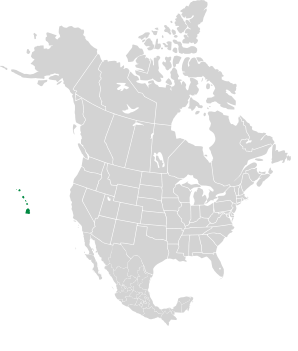Cyperus kyllingia Endl.

|
Kyllinga nemoralis (J.R. Forst. & G. Forst.) Dandy ex Hutch. & Dalziel White water sedge, whitehead spikesedge, white-flowered kyllinga, nut grass
This native of Australia (Queensland) and some Pacific islands has become naturalized in Hawaiʻi, where it is considered an alien invasive. It is found in shaded meadows, rock crevices and along roadsides. Plants: These perennials spread via creeping rhizomes. Their culms are tufted or spaced, standing straight, up to 1½′ (55 cm) in height. Like other sedges, the culms are triangular in cross-section. Leaves: Grasslike leaves are linear, almost as long as the culms, 1/32-⅛″ (1.5-3 mm) wide. Leaf sheafs are brown or purple-brown. Flowers: Flowerheads are roughly spherical, ⅛-⅜″ (5-10 mm) around. Usually there is a single flowerhead, but up to three smaller heads may be fused to the largest one. Beneath the flowerhead are 3 or 4 long bracts, grasslike spikes, up to 8″ (20 cm) in length. Medical: White water sedge is used by:
When a single plant has a wide range of disaparate uses reported, I can’t help but wonder whether any of them are valid. But a 2011 paper, “Kyllinga nemoralis (Hutch & Dalz) (Cyperaceae): Ethnobotany, Phytochemistry and Pharmacology,” summarized: “An exhaustive survey of literature revealed that flavonoids, saponins, phenols, terpenes, lipids and glycosides constitute major classes of phytoconstituents of this plant. Pharmacological reports revealed that it is having analgesic, antidiabetic, anticancer, antioxidant, antimicrobial, hepatoprotective and antimalarial properties.” These are similar: |
7/29/2023 · Puaakaa State Park, Hana Highway, Maui, Hawaii · By Forest and Kim Starr 7/29/2023 · Puaakaa State Park, Hana Highway, Maui, Hawaii · By Forest and Kim Starr 7/29/2023 · YMCA, Keanae, Maui, Hawaii · By Forest and Kim Starr 7/29/2023 · Puaakaa State Park, Hana Highway, Maui, Hawaii · By Forest and Kim Starr |
||||||||||||||||||||||||||||
|
| |||||||||||||||||||||||||||||
Eriophorum vaginatum var. spissum |
Eriophorum virginicum |
Rhynchospora colorata |
|||||||||||||||||||||||||||
|---|---|---|---|---|---|---|---|---|---|---|---|---|---|---|---|---|---|---|---|---|---|---|---|---|---|---|---|---|---|
| Common Name |  |
 |
 |
||||||||||||||||||||||||||
| Plant | Stems (culms) are round, oval, or triangular in cross section. The stems are very thin, about 11.8 mils (0.3 mm), and densely packed into tussocks. | Stems are not branched, hairless, and 1-4′ (40-121 cm) in height. They are single, or in small groups, with round or slightly triangular cross sections. | Grasslike clumps or solitary plants. Each is topped with a “flower” comprised of 3-10 specialized green and white leaves. The “petals” are really specialized leaves (bracts), each up to 5″ (13 cm) × 1/16-¼″ (2-7 mm). Stems are triangular in cross section. | ||||||||||||||||||||||||||
| Flowers | Flowers appear in a compact cluster at the tip of the stem, appearing elliptic at first, then more hemispheric as the plant matures. If you look closely, the numerous flowerheads are arranged in a spiral pattern. The cottony flowerheads are ¾-2″ (1.9-5 cm) in size, erect (vs. nodding) and are white (vs. brownish). | Although they often look like a single tuft of cotton, the tuft is comprised of 2-10 densely packed spikelet clusters. The lowermost spikelets are wrapped in leafy bracts, like tiny ears of corn. Each spikelet is ⅛-⅜″ (6-10 mm) long. Ten or more threadlike bristles—the “cotton”—extend from the base of each flower. The threads eventually become up to ¾″ (2 cm) long, usually brown at the base, and somewhere between off white and brown or red-brown as the plant ages. The red-brown color distinguishes tawny cotton-grass from other cotton grasses. (More subtle identifiers include a single stamen per floret instead of 3, and multiple veins on the scales of the seedheads.) Flowers appear from Jun to Sep. | A dense cluster of small spikelets ⅛-¼″ (5-7 mm) long, nestled amidst the bracts. Each spikelet is white, ovoid, and contains several tiny flowers. They appear in June and July. | ||||||||||||||||||||||||||
| Leaves | There are a few basal, alternate leaves, and a few higher up, but they are easy to miss amongst the many stems. Each leaf is up to 1/32″ (1 mm) wide, resembling a grass blade, and may be nearly as long as the stem. | Alternate, up to 1′ (30 cm) long × 1/32-⅛″ (1.5-4 mm) wide. They are linear, flat at the base, becoming triangular in cross section as they approach the tip, with parallel veins. They may be erect, or floppy. | Grasslike, linear, arising from the base of the plant in clusters, spreading or erect, 1/32-⅛″ (0.5-3 mm) wide. | ||||||||||||||||||||||||||
| Fruit | 1/16-⅛″ (1.9-3.5 mm) long. They are triangular to rounded in cross-section. White bristles around the base of each flower extend in length, becoming ¼-¾″ (8.3-19 mm) long, producing the “cotton.” Seeds (achenes) are 1/16-⅛″ (1.9-3.5 mm) long, and shaped like teardrops. They are three-sided when viewed in cross section. | Fruits appear from July to September. The achenes are 1/16-⅛″ (2.5-4 mm) long, shaped like a narrow ellipse with a triangular or rounded cross section. They are brown or black. | Spikelets mature to a yellow to mahogony color. Each spikelet contains several fruits, each 1/32-1/16″ (1.5-1.7 mm) in size. Fruits appear in late spring to summer. | ||||||||||||||||||||||||||
| Range/ Zones |
|
|
|
||||||||||||||||||||||||||
| Habitats | Peaty bogs and acidic wetlands. | Wet, peaty, acidic soil, such as bogs, damp meadows, and conifer swamps. | Wet coastal areas, dunes, flatwoods, wet prairies, swales and roadside ditches | ||||||||||||||||||||||||||
| Type | Wild | Wild | Wild | ||||||||||||||||||||||||||


Online References:
HEAR: the Hawaiian Ecosystems at Risk project
7/29/2023 · Kahului, Maui, Hawaii · By Forest and Kim Starr 
Cyperus kyllingia Endl.
Kyllinga nemoralis description by Thomas H. Kent, last updated 16 Sep 2020.
© FloraFinder.org. All rights reserved.
Range:
